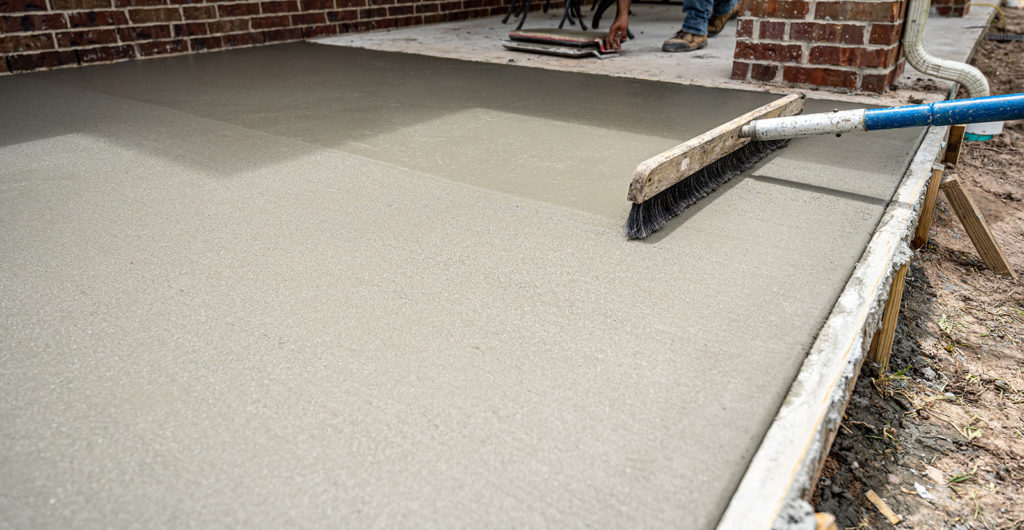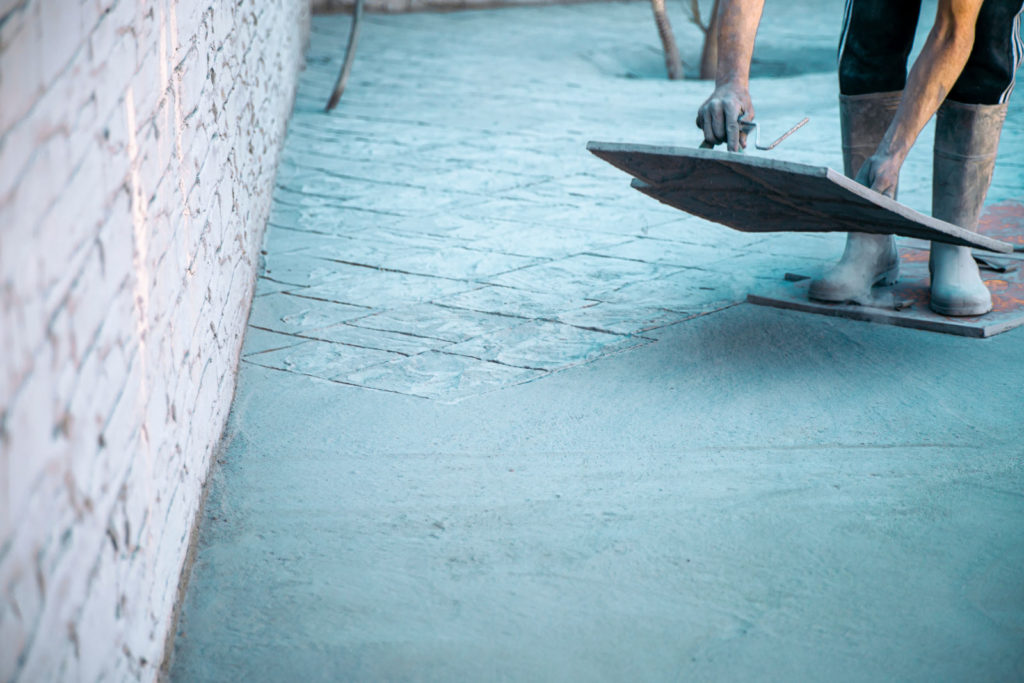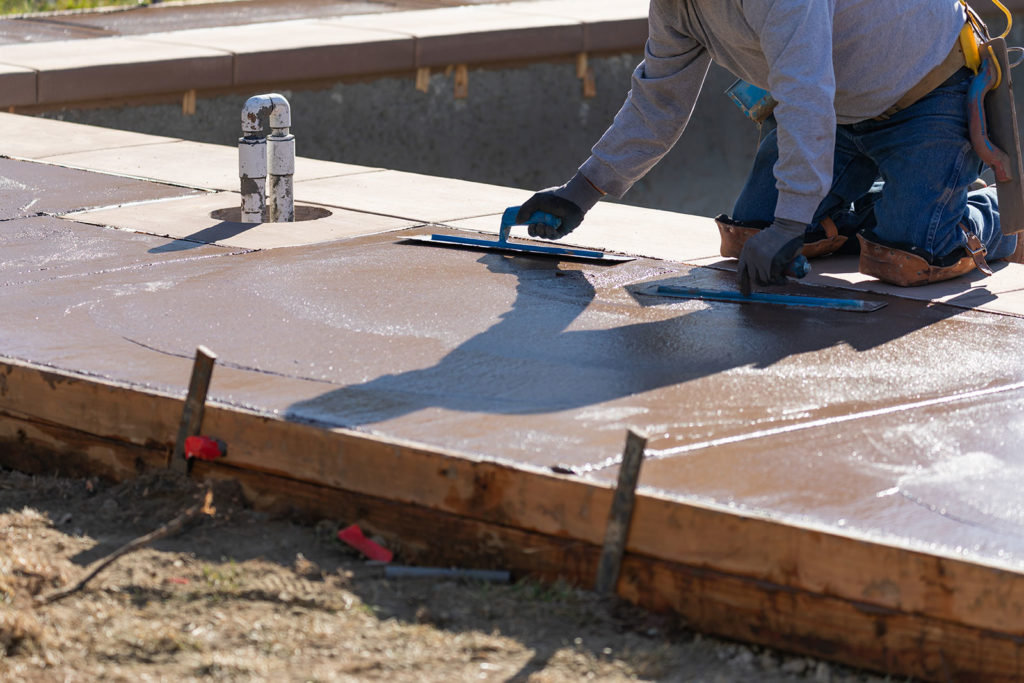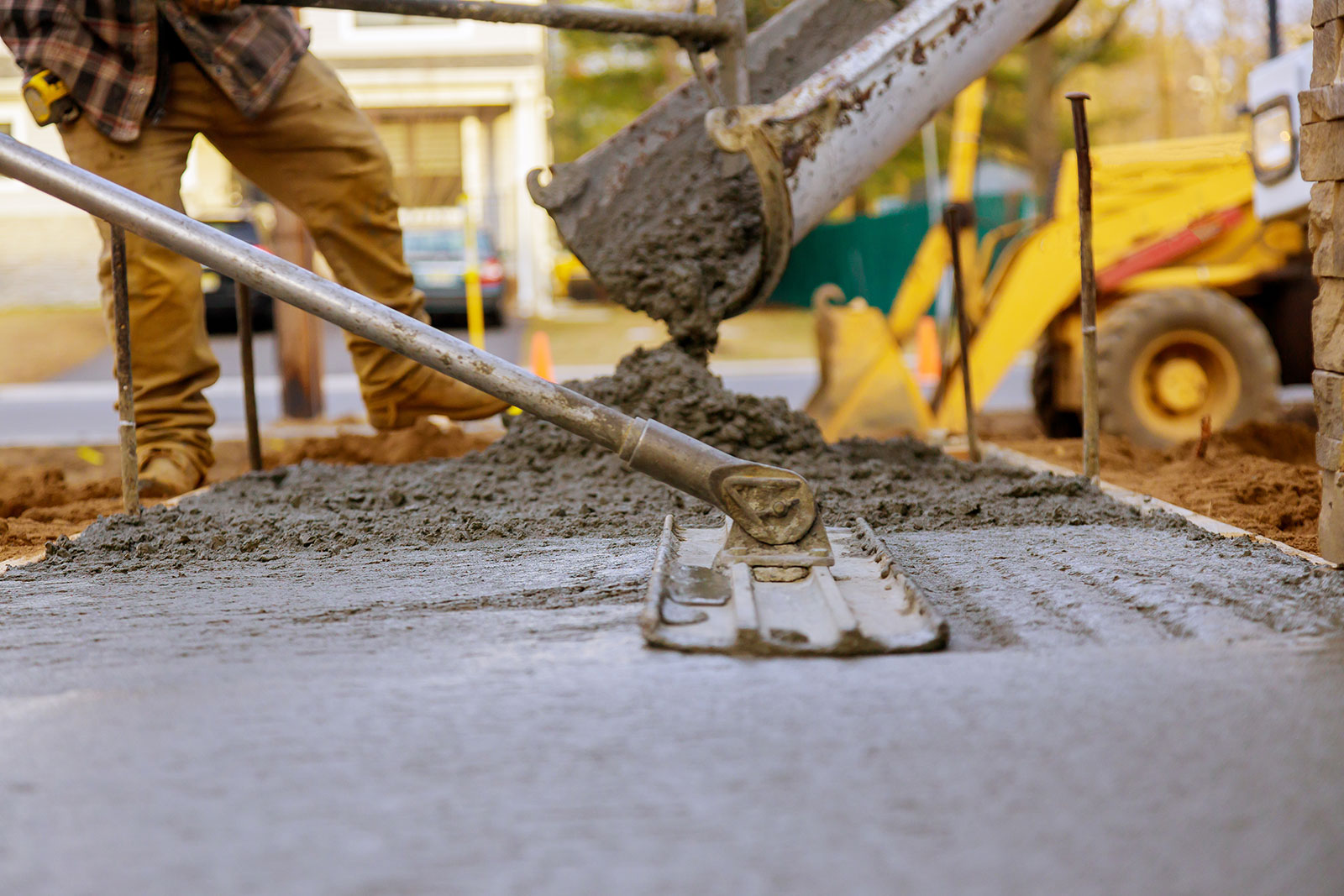Swimming pools are an essential part of any home and are often one of the most popular features homeowners add. However, choosing the right type of concrete for your pool surround can be challenging. This article will compare stamped vs. brushed/broomed concrete for swimming pools.
What is Brushed/Broomed Concrete?

Brushed/Broomed Concrete is a type of concrete that has been smoothed or broomed finish. This process creates a surface that is easier to walk on and eliminates the need for sealant. It is typically used in areas close to pedestrians, such as sidewalks and entryways. This concrete is often used for swimming pools because it is less noticeable and easier to clean.
What is Stamped Concrete?

Stamped concrete is a type of concrete created by pressing small metal discs into the surface of the concrete. The metal discs create small indentations in the surface, which helps to hold the concrete together and resist wear and tear. This type of concrete is often used for swimming pools because it is less likely to crack or chip than other types of concrete.
Differences Between Stamped and Brushed Concrete
Stamped concrete, also known as troweled concrete, is created when a layer of heavy-duty sand is spread over the surface of the concrete and then troweled into place. The sand helps to create a smoother finish and resists moisture infiltration, which is beneficial for swimming pools.
Brushed concrete, on the other hand, uses a handheld machine that vibrates back and forth over the surface of the concrete, creating a high-pressure airflow. This process creates a rougher finish that is less prone to moisture infiltration and corrosion. It also has better slip resistance than stamped concrete.
Brushed concrete looks like sandpaper and is easy to clean. However, it can’t hold a stain or stamped concrete, so it’s not ideal for areas that will be frequently exposed to moisture.
Stamped concrete has small bumps or indentations on its surface, which helps it to resist water seepage and staining. It’s also more resistant to weathering, so that it may last longer than brushed concrete in outdoor areas.
Brushed concrete might be a better choice if you only plan to use your patio occasionally because it’s easier to clean. Stamping your concrete may be wiser if you use your deck more often since it will last longer and look nicer.
Ultimately, it comes down to personal preference regarding which type of concrete best suits your needs. Stamped concrete may be a better choice if you are looking for a smoother finish. If you want more slip resistance, brushed concrete may be better suited.
Brushed Concrete vs. Stamped Concrete Maintenance
Brushed concrete is made by rubbing a machine with a wire brush on the surface of the concrete. This creates a rough finish that needs to be regularly sealed and maintained.
Stamped concrete is created by pouring a thick mortar into a mold, then pressing the concrete into the mold. This results in a smoother finish that doesn’t need regular maintenance.
Brushed Concrete vs. Stamped Concrete Aesthetics
Regarding aesthetic appeal, both brushed and stamped concrete can be attractive options for swimming pools. However, stamped concrete may be the better choice if you want a more durable finish.
Brushed Concrete vs. Stamped Concrete Cost
Concerning stamped vs. brushed concrete for swimming pools, many homeowners are uncertain of the cost difference between the two types of construction. While both options can be expensive, brushed concrete may be a better choice for some pools.
Brushed concrete is more affordable than stamped concrete in most cases and requires less labor. Brushing concrete creates a smoother finish that is less likely to harbor bacteria and algae. This means your pool area will stay cleaner longer, and you won’t need to replace filters often. Additionally, brushed concrete is slightly more challenging than stamped concrete to withstand harsher weather conditions.
Stamped concrete may be your best option if you’re looking for a durable pool surface. However, brushwork may be better if you’re on a budget or want to keep your pool clean and more uncomplicated.

Brushed Concrete vs. Stamped Concrete Safety
When it comes to swimming pools, most people prefer stamped concrete over brushed concrete. But is one safer than the other?
Brushed concrete is typically made up of small, rounded pieces of concrete that are not stamped together. This type of concrete is less likely to cause injuries when people accidentally fall on it or splash into the pool.
Stamped concrete, on the other hand, is created by stamping together large pieces of concrete. This type of concrete can be more dangerous because people may fall onto it or splash it if it’s not maintained correctly. Additionally, stamped concrete may become slippery if wet, leading to accidents.
Whether you’re opting for stamped or broomed concrete, there are a few things to keep in mind:
- Size and Shape of the Pool: Stamped concrete may be a better option if your pool is small or irregular. It’s easier to get a consistent finish with stamped concrete than with broomed concrete, which can vary in grain size.
- Type of Material: Stamped or broomed concrete is typically made from two different types of materials – aggregate (small rocks) and cement. Aggregates are used to create the texture and shape of the finished product, while cement creates the complex finish.
- Cost: Swimming pool stamped concrete can be less expensive than broomed concrete, but it’s essential to factor in the cost of additional materials.
Which should I choose?
Regarding swimming pools, stamped concrete or brushed/broomed concrete? Which is better, stamped or brushed/broomed? Both methods have pros and cons, but which is best for your needs? Here are the details:
Advantages of Stamped Concrete:
- A stamped concrete swimming pool looks more natural and blends better with the surroundings.
- This pool is also more resistant to corrosion and algae growth, making it a better choice if you have children or pets.
- It’s relatively easy to keep clean, as all you need to do is sweep the surface.
- This type of pool is also cheaper to build than a brushed or broomed pool.
Disadvantages of Stamped Concrete:
Stamped concrete pools can be more challenging to maintain over time, as they tend to crack and require more frequent repair work than other pools.
- It’s not as durable as brushed/broomed concrete. Stamped concrete is susceptible to cracks and other damage due to moisture, sunlight, and temperature extremes. Over time, this can lead to instability in the pool floor and walls.
- It’s less resistant to bacteria and algae growth. This is because stamped concrete doesn’t have a uniform texture, which allows bacteria and algae to grow more efficiently. In addition, the residue left over from the stamping process can attract these organisms.
- It’s more expensive than brushed/broomed concrete. Because stamped concrete is made from smaller pieces less dense than regular concrete, so it costs more to produce and install. Furthermore, stamped concrete tends to be more difficult to seal and finish than brushed/broomed concrete, which can add to its cost.
- Stamped concrete may not adhere well to the surrounding surface
Advantages of Broomed/Brushed Concrete:
- This type of pool surround is less expensive to build than a stamped pool and requires less maintenance.
- It’s also easier to keep clean, as all you need to do is sweep the surface.
- Brushed concrete is cheaper than stamped concrete and requires less installation labor.
- Brushed concrete has a smoother finish, which makes it more aesthetically pleasing.
- It has a longer lifespan than stamped concrete, which means it will maintain its appearance for longer.
- Brushed concrete is less likely to require maintenance than stamped concrete.
- Brushed concrete is easier to clean than stamped concrete.
- Brushed concrete is lighter than stamped concrete, making it easier to move and install.
Disadvantages of Brushed/Broomed Concrete:
- Brushed/broomed concrete has a rougher surface that can be difficult to clean.
- This could cause cracks in the concrete and allow water infiltration.
Conclusion
Swimming pools are a significant investment, and it’s essential to make sure you choose the suitable material for your pool. Concrete is a popular choice for swimming pools because it is durable but can also be damaged if not properly maintained. Swimming pool resurfacing can cost up to $10,000, so choosing the best concrete for your pool is essential.
Stamped vs. brushed/broomed concrete has become controversial in recent years because both methods have pros and cons. Brushed/broomed concrete has been shown to last longer and is more rugged than stamped concrete.
On the other hand, stamped concrete is more expensive and is fancier, but it may not be as durable as brushed concrete. It’s essential to decide which features are most important to you before deciding which type of concrete best suits your needs.
FAQ
What is the best finish for concrete around a pool?
Is stamped concrete a good idea around a pool?
What is the difference between stamped and brushed concrete?
Is stamped concrete too slippery around a pool?

